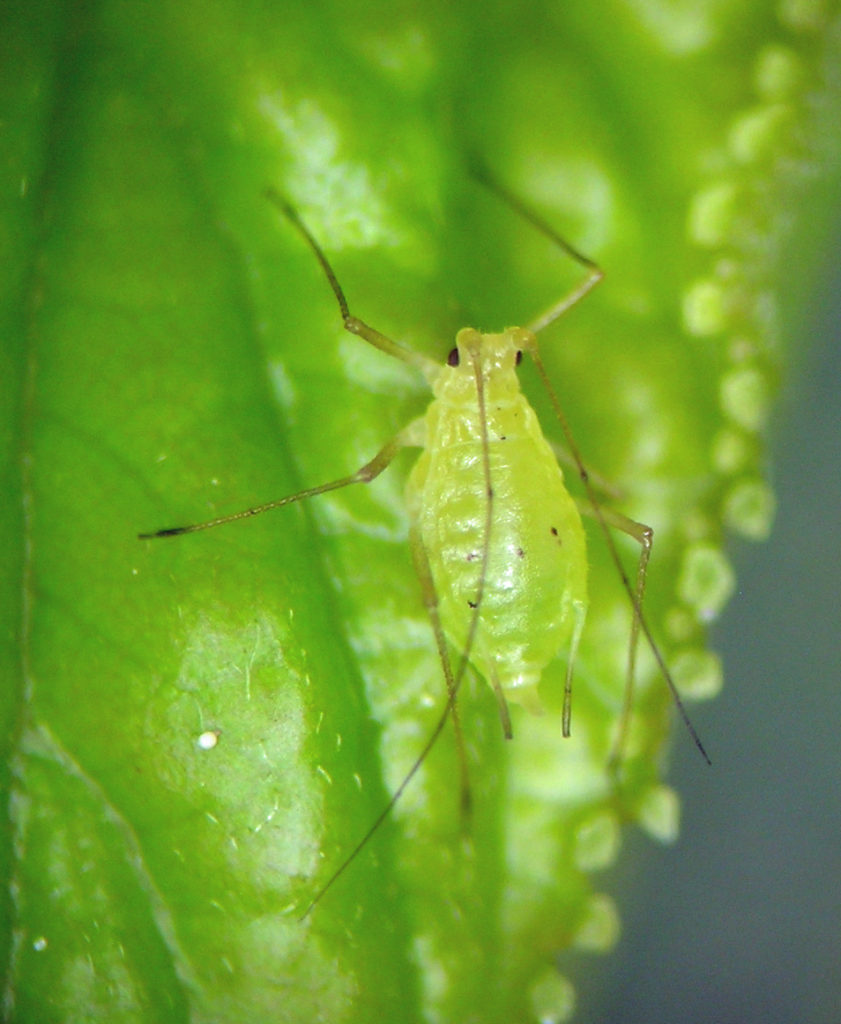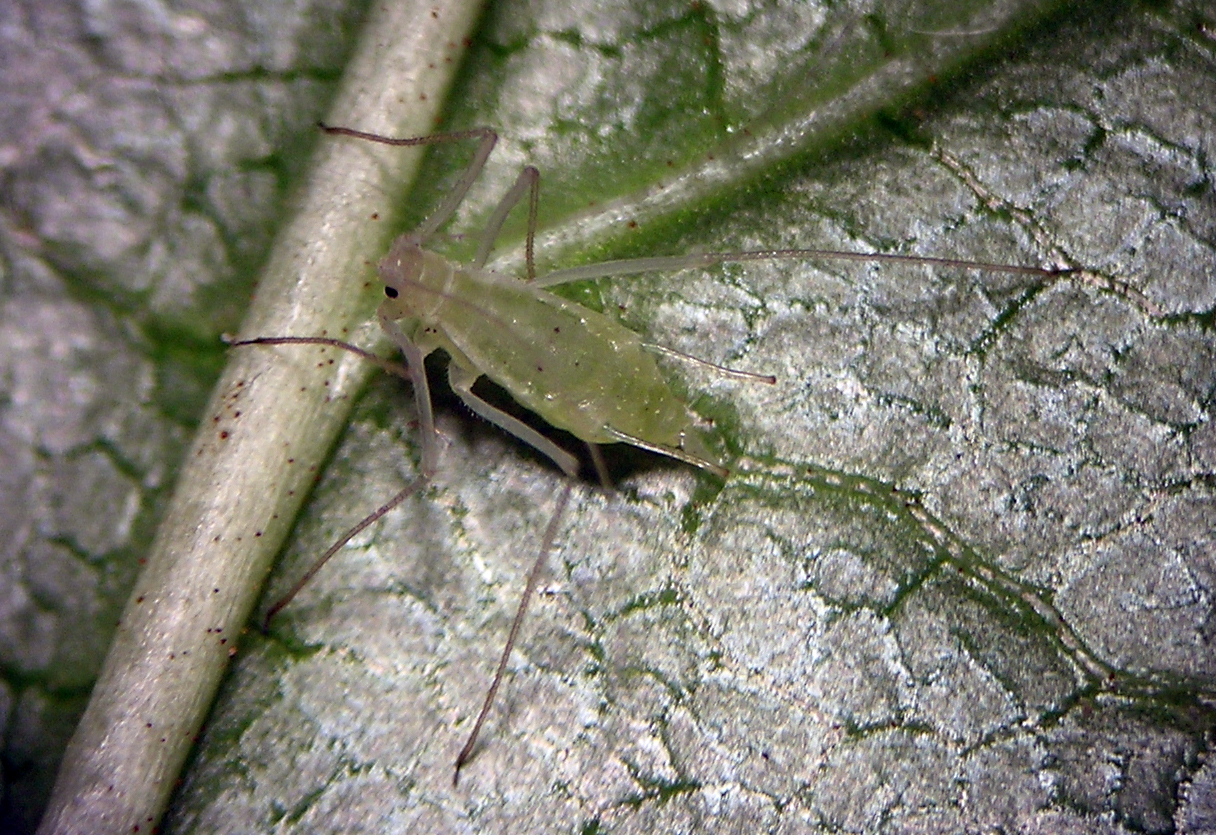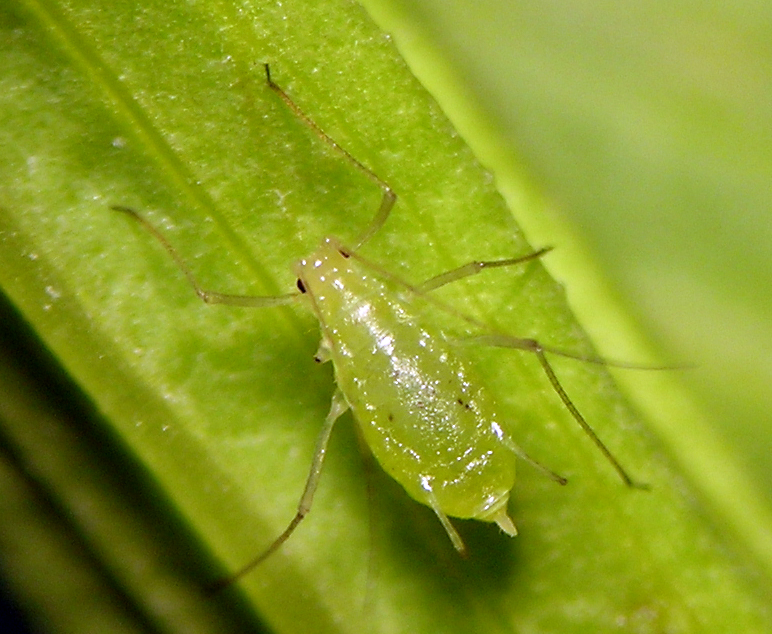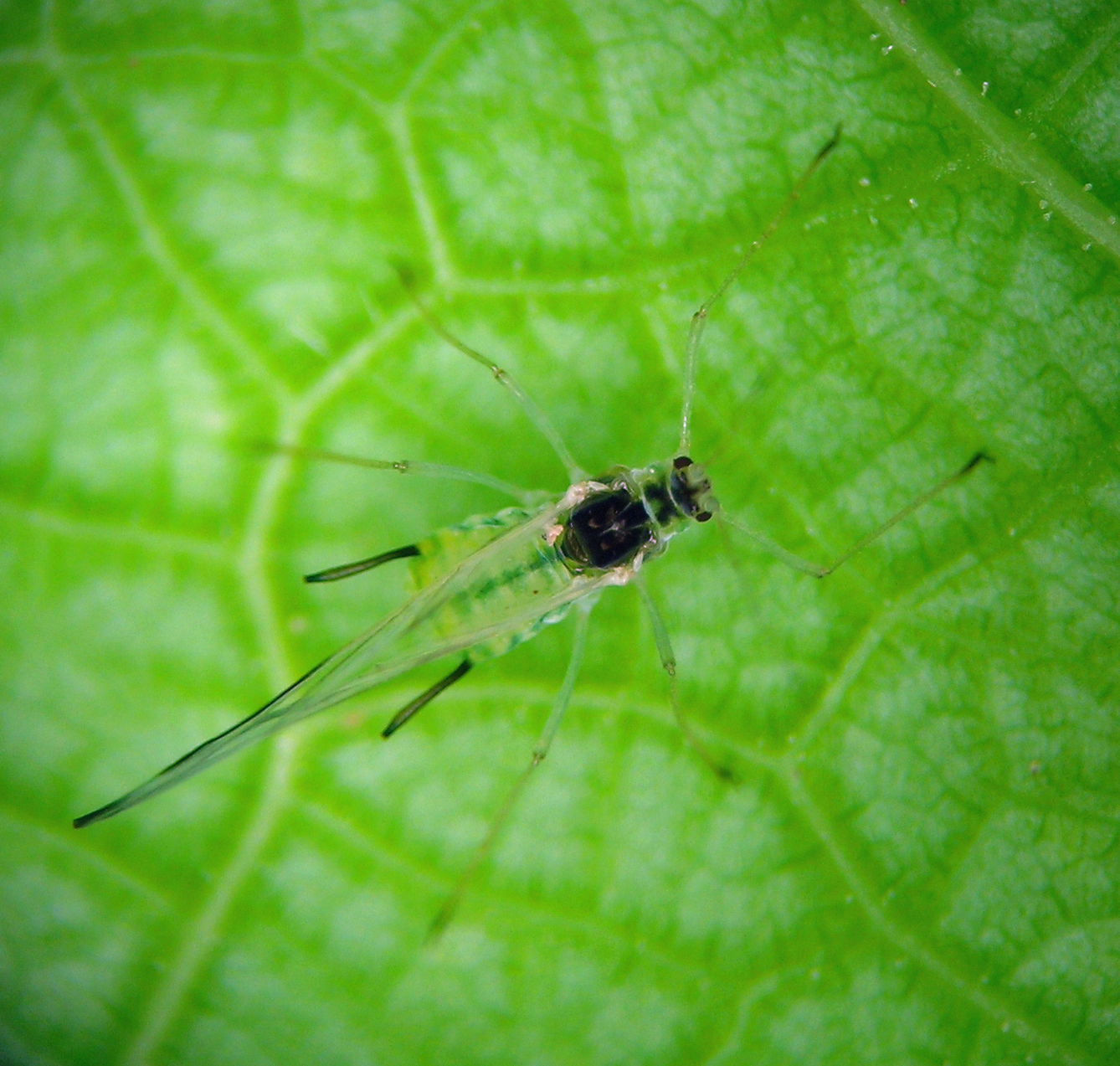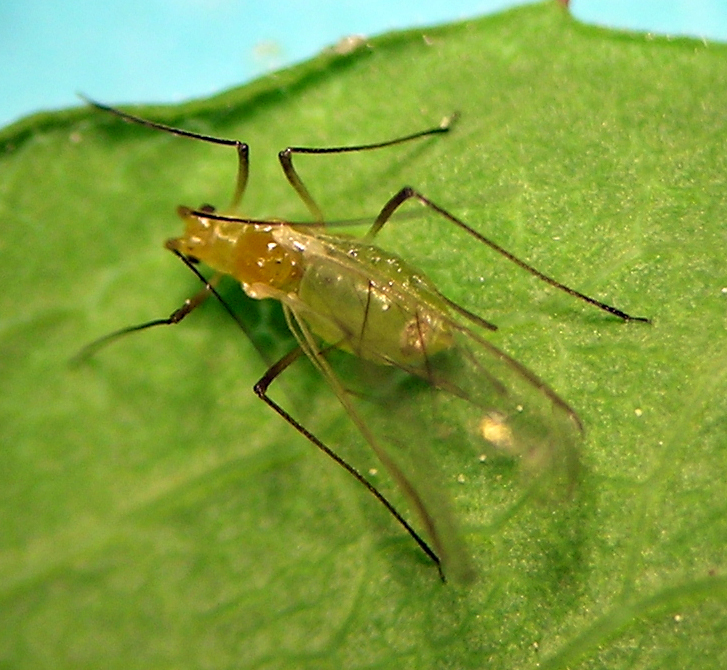Illinoia Wilson
This page updated: December 2024.
This is one of the groups I study extensively in the field, and puzzle over in the lab. It is almost entirely North American and is likely very closely related to Macrosiphum; in fact the two genera might be better thought of as a mish-mash of similar species haphazardly assigned to genera based on a possibly trivial character, i.e. clavate siphunculi. But as you’ll see from careful study, some species placed in Macrosiphum have clavate siphunculi as well. So what gives? Hard to say. Probably extensive field work and fresh collections for DNA analysis would be required to clarify the genus-level classification. Meanwhile, there are many cool and easily recognized species of Illinoia to enjoy in the field.
The 2017 collecting season was very productive for me in terms of Illinoia. During winter of 2018 I therefore spent some time sorting many of the unidentified Illinoia from many hosts. One main accomplishment was deciding what to consider as Illinoia thalictri MacGillivray. I knew I had at least two species of the genus from Thalictrum, but had not taken the time to decide which should be considered I. thalictri. See below for a photo and an account of this species. One highlight of my collection work is listed below, and the re-arrangements and species name assignments were reflected in the slide collection database when the 2018 version was released. A paper published January 2021 reveals the identity of most Illinoia living on Holodiscus to be I. gracilicornis (MacGillivray). I worked on Illinoia classification again in fall of 2020 and decided to broaden what I identify as I. corylina to include most specimens living on Corylus, Aguilegia, and Thalictrum (the latter two genera both in Ranunculaceae). These specimens are obviously different from another species, possibly I. macgillivrayae, that also lives on Corylus (see below for more information).
The year 2021 was our first living in western Colorado. It was overall a light year for collecting Illinoia, with the exception of samples from various Asteraceae. My first collecting goal here was finding Illinoia masoni, which is known to feed on native Helianthus (the sunflower genus). To my surprise, finding this species was easy — it lives on native Helianthus and apparently other Asteraceae herbs all over our local mountains. I had wondered whether this species would be morphologically distinguishable from others of the genus living on Asteraceae, such as I. goldamaryae, I. grindeliae, and I. subviride. During December of 2021 I carefully sorted through the specimens I had identified as all of these 4 species. Making a long story short, I was able to make most of the specimens fit into 4 groups, and was able to make a case for species name assignments for each group based on old literature. The collection database released in 2022 will therefore reflect some changes in determinations. Going into this sorting process I understood that 3 of these 4 species had a fairly tight host range. I thought I. grindeliae fed on Grindelia, I. masoni on Helianthus, I. subviride on Aster/Erigeron, and I. goldamaryae was thought to be oligophagous on several Asteraceae genera. Now, it seems clear to me that: I. grindeliae feeds on various desert-inhabiting Asteraceae including Grindelia, Heterotheca, and a couple others I couldn’t identify; I. masoni seems to feed on several genera in wet montane forests, including Helianthus, Helianthella, and Erigeron; so far I. subviride does in fact seem to feed only on Aster/Erigeron. This messy sorting job then made me wonder whether these Asteraceae-feeding species can be distinguished from the I. macgillirayae/spiraeae group? A quick glance indicates that much study will be needed to understand Illinoia species delimitation, host ranges, etc.! No characters screamed out to me saying that none of the Asteraceae-feeders are in fact part of that shrub-feeding group. What a taxonomic mess it would be if we learned that most Illinoia species are oligophagous or polyphagous! I think I need to set aside some time in retirement to do host transfers among all sorts of plants using local Illinoia.
An update for 2022 on the Asteraceae-feeding Illinoia in western U.S. after much collecting in 2022 and examination of those specimens: in addition to the species mentioned above, I was able to sort 6 additional morphospecies from all my Asteraceae-feeders. I fear that I am confirming that Illinoia species mostly are not tightly host specific, and have overlapping geographic ranges and morphological features. As part of my first retirement-era work, I spent a few days in the fall of 2024 going through this material again. No new epiphanies emerged — Illinoia on Asteraceae remain very difficult and an example of more collecting resulting in less taxonomic clarity.
Unidentified species on Chamaebatiaria millefolium, fern bush: when I first found aphids on this plant in SE Idaho in 2015, I wrote Acyrthosiphon on the label due to the more or less cylindrical siphunculi without reticulation. Since that time I have collected this apparently single species in a few places in California and Nevada. In some samples the apterous viviparae have a couple rows of reticulation on the siphunculi, and the male and alate vivipara possess distinct reticulations and look like more typical Illinoia. In other respects the range of variation and the unusual features of the aphid suggest that a single species is involved. One of the unusual features is the long siphunculi, slightly outwardly curved, with swelling near the apex, and a trend of 1-3 small setae near the base in the larger specimens. These features of the siphunculi are similar to Acyrthosiphon macrosiphum Wilson. To my surprise this aphid has somehow found, or been transported with, an ornamental fern bush that we planted in our Colorado yard. This presents a fun opportunity to study an unusual aphid right here at home.
Unidentified species on Monardella in the mountains of New Mexico: During our almost-annual fall visit to New Mexico, I spend 2 or 3 days collecting aphids and have found many interested samples over the years. One I’ve pursued each time I visit the Magdalena Mountains is an Illinoia that lives on Monardella (Lamiaceae) near the summit of South Mountain. In 2022 I was able to get large numbers of specimens including the sexuales (males are alate). Evaluation of all my material indicates that this species is recognizable and probably undescribed.
Species covered below (click on the name to jump to that species):
- Illinoia ceanothi (Bartholomew)
- Illinoia corylina (Davidson)
- Illinoia (Amphorinophora) crystleae (Smith & Knowlton)
- Illinoia goldamaryae (Knowlton)
- Illinoia gracilicornis (MacGillivray)
- Illinoia (Oestlundia) maxima (Mason)
- Illinoia (Masonaphis) menziesiae Robinson
- Illinoia (Masonaphis) rhododendri (Wilson)
- Illinoia richardsi (MacGillivray)
- Illinoia spiraeae/macgillivrayae
- Illinoia thalictri (MacGillivray)
Illinoia ceanothi (Bartholomew)
This is an unusual species of Illinoia, with some unusual morphological features, such as the almost annular imbrications on the antennae, the almost lack of reticulations on the siphunculi, and the spinulose imbrications on those siphunculi. Also, it is an unusually fast running aphid when disturbed on its Ceanothus host plants. It is monoecious holocyclic, feeding on at least a couple species of Ceanothus (e.g. C. velutinum and C. cordulatus). I have tapped on hundreds and hundreds of Ceanothus bushes over the years, and am satisfied that this aphid is quite rare in most places I’ve traveled. I have samples from Washington, Oregon, Idaho, and California.
Illinoia corylina (Davidson)
During fall of 2020 I re-evaluated the Illinoia in my collection, particularly the specimens categorized as I. spiraeae/macgillivrayae. I also looked at my material identified as I. corylina collected from both Corylus and Aquilegia. Fresh eyes and mind brought about by 2 years of not diving into these specimens allowed me to recognize that most of my material from Corylus, Aquilegia, and Thalictrum share important features and seem to belong to a single species. These features include relatively numerous sensoria on antennal segment III, and much longer dorsal and antennal hairs. Some of the specimens I have seen developing on Corylus in the spring are a different species, such as I. macgillivrayae (see below), and of course much material from Thalictrum is I. thalictri. The host association of I. corylina with Aquilegia was suggested by other specialists many years ago. After examining my many specimens from all three hosts, I see that this early speculation was correct and I am stretching the idea to include Thalictrum, another Ranunculaceae.
I have identified this species from Washington, Oregon, California, Montana, Idaho, Utah, and British Columbia.
Illinoia (Amphorinophora) crystleae (Smith & Knowlton)
I have a lot of affection for this species, and have pursued it avidly in the field for over 20 years. It lives on one of our native honeysuckles, Lonicera involucrata (a host whose berries were described as inedible and possibly poisonous, “but they are so disgusting that there is little chance of anyone eating enough to worry.” Plants of the Rocky Mountain Region). My gut feeling (forgive the pun) is that this species belongs to a Caprifoliaceae-associated lineage that includes Macrosiphum stanleyi, Macrosiphum raysmithi, Macrosiphum diervillae, Macrosiphum schimmelum, and a few others. This is another research topic I invite others to pursue. It’s a very interesting biogeographical puzzle. I so far have this species from the ocean to rather high mountains; states/provinces include: British Columbia, Washington, Oregon, Idaho, Utah, and Colorado.
Illinoia goldamaryae (Knowlton)
As mentioned at the top of this Illinoia page, this is one of possibly several recognizable Illinoia sensu stricto species that live on Asteraceae. I have identified this species from several different host genera, but I am currently wondering whether samples from plants other than Solidago may be other species.
The place I was most able to study it and collect all its life cycle stages was on Solidago on the shores of Moses Lake in central Washington. I have fundatrices, oviparae, and alate males from Solidago. My specimens are from: Washington, Oregon, Idaho, Montana, Utah, Colorado, and Wyoming.
Illinoia gracilicornis (MacGillivray)
For many years I have been collecting unidentified Illinoia from Holodiscus all across the western U.S. and Canada. A paper was published January 2021 that revealed the identity of almost all these Illinoia. I wrote the following about it in that paper.
“MacGillivray (1958) described this species based on two oviparae collected in western Colorado in September of 1956 with the host plant recorded as Cercocarpus montanus. As discussed above under Aphis cercocarpi, I suspect that all records of aphids on Cercocarpus in western USA represent misidentifications of Holodiscus. Evidence supporting this idea is the description of I. gracilicornis, in which MacGillivray (1958: 74) stated, “Though only oviparae of this species are known there is little doubt that it is undescribed. Among species with 3 hairs on the 1st tarsal joints it stands apart because the hairs on the VIIIth abd. tergite are unusually long in comparison to the thin swollen area of the siphunculi so that recognition is easy.” After many years of looking for this aphid on Cercocarpus, I realized during study of my specimens collected on Holodiscus that they shared with I. gracilicornis this feature of unusually long setae on ABD 8. Herbarium records from Colorado showed that both C. montanus and H. dumosus grow in the area of Carson’s Hole, Colorado, the type locality of I. gracilicornis. One of the cotype specimens of I. gracilicornis was therefore borrowed from the BMNH, easily confirming that samples from Holodiscus and MacGillivray’s species are morphologically indistinguishable and should be considered conspecific.
All evidence available as of this writing indicates that this species is monoecious holocyclic on Holodiscus. Especially convincing on this point are the apterous males and regular detection of apterae throughout the summer. As noted below, there is some uncertainty about the conspecificity of the material from H. dumosus versus from H. discolor. Additional collecting of Illinoia from H. discolor across the west may reveal an as–yet–undetected heteroecious life cycle of populations using that host plant. That said, samples collected in mid-July 2020 near Coeur d’Alene, Idaho strongly argue for a monoecious life cycle.
As noted above, the determination of samples as I. gracilicornis was made based on the suspicion that the original collection of this species by Hottes and Hille Ris Lambers was based on a misidentification of the host plant as Cercocarpus rather than Holodiscus. Both plants have been seen growing in proximity, and in fact the collection site of most oviparae and males in Chaffee County, Colorado was home to a mixture of large Holodiscus and Cercocarpus shrubs on the same slope.
This species seems to live wherever H. dumosus occurs, from mid–elevation forests to higher elevation mountain–top rock outcrops. This means that its annual growing season varies greatly in length. A simple demonstration of this is the collecting dates of the available fundatrices from the Warner Mountains in Lake County, Oregon: 19 May on the slope below Abert Rim (an open rocky west–facing slope at about 1500 m elevation), 11 June in the sparse forest of Can Spring (a partially shaded northeast–facing stream drainage at about 1900 m elevation), and 2 July on the summit of Crane Mountain (an exposed rock outcrop on a mountain top, about 2500 m elevation). The Abert Rim location’s growing season in most years will be early May through mid–October, the Can Spring site slightly shorter, and the Crane Mountain site will usually be early July through early September, i.e., the life cycle will vary for this species from about 2.5 months to about 5 months, all within the same mountain range.
So far this aphid is known from southern British Columbia, Washington, Idaho, Oregon, Nevada, California, Colorado, and Arizona.”
Illinoia (Oestlundia) maxima (Mason)
This is a beautiful aphid that can be found on Rubus parviflorus (thimbleberry) in the moist parts of northwestern North America. As noted by Blackman and Eastop, it has an abbreviated life cycle and is monoecious on this shrub. I have samples from British Columbia, Washington, Oregon, and California.
Illinoia (Masonaphis) menziesiae Robinson
This is an interesting species that is an example of an ‘Illinoia‘ with little to no swelling in the siphunculi. It is also unusual in that it causes discoloration of the leaves on which it feeds (host being Menziesia ferruginea, Ericaceae). Once I learnt to recognize Menziesia from among all the other nondescript shrubs in northern Idaho, this aphid was easy to find. Another interesting tidbit is that the specimens collected on Menziesia near the ocean coast in Oregon’s Tillamook County differ rather markedly in morphology from specimens collected east of the Cascade Range in Washington, Idaho, and Montana; the leaf discoloration symptom of infestation was the same. More study might determine that two species are involved.
Illinoia (Masonaphis) rhododendri (Wilson)
This is a fun species because its seasonal life cycle is so dependent on the phenology of its main host (Rhododendron macrophyllum). Blackman and Eastop’s website notes, “the life cycle is uncertain but may be abnormal, with fundatrices in late July, and possible early production of sexuales (MacGillivray 1958).” This species does indeed have an abbreviated life cycle, but when during the year it occurs depends on habitat of the host plant. Near the ocean, this aphid is active in April and May, with sexuales on the fruits in May and June. In the mountains, sexuales occur in September because the host plant is in fruit during that time. This aphid starts off the season in longitudinally rolled leaves and during the sexual stage moves to the developing fruits. I have material from Oregon and California.

Illinoia richardsi (MacGillivray)
This aphid is common and easy to find on its host Anaphalis margaritacea (Asteraceae). It has an impressively large, apparently natural distribution that reflects the distribution of its host across North America. I have specimens from Washington, Oregon, Idaho, Utah, Colorado, and Quebec.
Illinoia spiraeae/macgillivrayae
In my collection I group specimens together that might be identified as either I. macgillivrayae or I. spiraeae (in fact, several of the species known from Ericaceae are also very difficult to recognize when looking at the full range of material at hand). The reason for this is that, although I get the general trend in size of ultimate rostral segment and cauda that is used to separate these species, their distribution and broad host range almost completely overlap. This means separating the species is troublesome at best, and may be misguided if all these specimens in fact represent only one species. Illinoia in this general group are common in the mountains in Washington, Oregon, and Idaho. Alates can be abundant and found colonizing a wide range of plants on which they may or may not be able to complete development. The latter fact makes it hard to know the full host range of these Illinoia aphids, but here is a start on the list (update from winter of 2018, and another run at sorting this material was just as frustrating and resulted in what appears to be a continuous range of variation in features of the siphunculi, cauda, and rostrum):
Amaranthaceae: Polygonum
Betulaceae: Corylus
Caprifoliaceae: Symphoricarpos
Asteraceae: Hieracium, Senecio
Ericaceae: Arctostaphylos, Phyllodoce, Rhododendron, Vaccinium
Hypericaceae: Hypericum (an Illinoia is commonly found in the Pacific Northwest on invasive and ornamental Hypericum)
Orobanchaceae: Pedicularis
Rosaceae: Amelanchier, Crataegus, Geum, Holodiscus, Prunus, Sorbus, Spiraea
Salicaceae: Salix
I’m starting to lean toward the idea that most of these specimens belong to one variable polyphagous species that lives on woody and herbaceous plants in several families across the whole west.
Illinoia thalictri (MacGillivray)
During winter of 2018 I sorted through my many slides of material of Illinoia collected from Thalictrum all across the west. I had intentionally been saving material from this host until I had samples from many locations and times of year, allowing better-informed decisions about which samples represent I. thalictri. In the end, my samples from the Rocky Mountain region seem to group together based on a relatively short ultimate rostral segment, and seem to comport with the idea of I. thalictri laid out by MacGillivray. Therefore, I added species names to quite a few slides. In some regions closer to the Pacific Ocean, Illinoia from Thalictrum have a markedly longer ultimate rostral segment and pretty clearly a different species, possibly in the Illinoia macgillivrayae/spiraeae group mentioned above. I’ve now identified this species from Idaho, Wyoming, Utah, Colorado, New Mexico, and Arizona.

